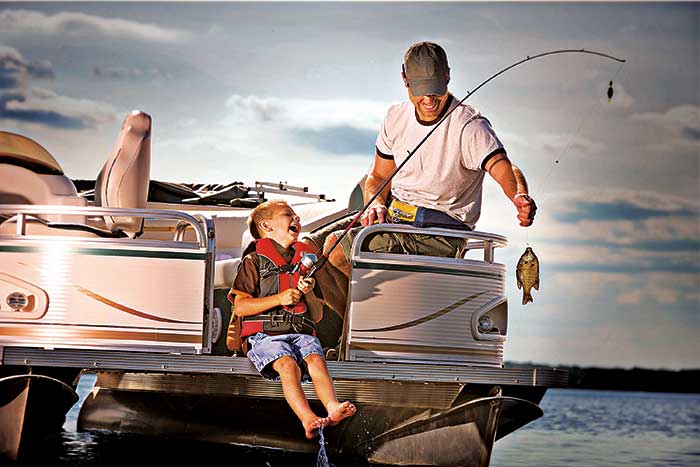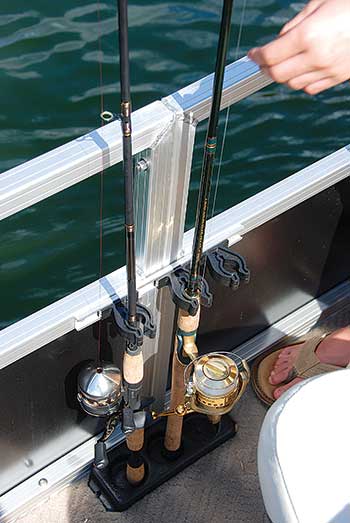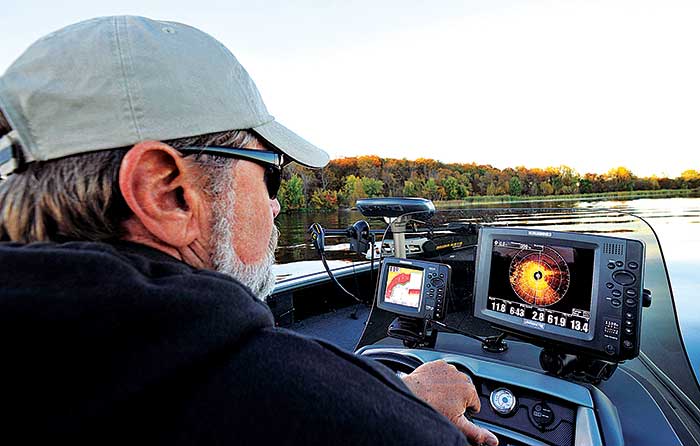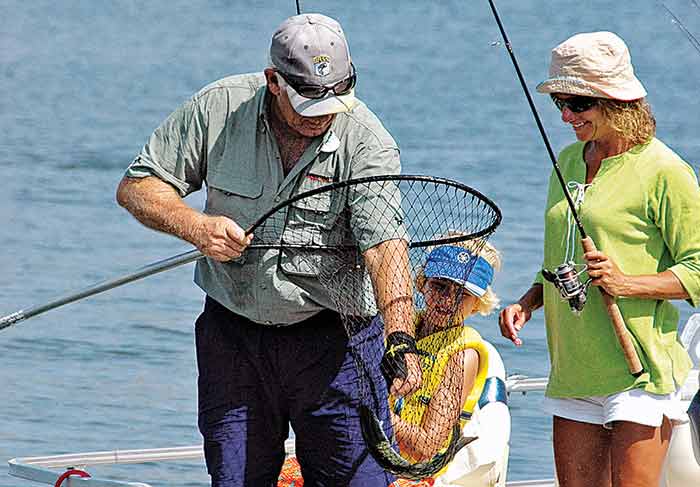Advertisement
A few simple additions can turn your family boat into a fisherman-friendly angling platform.

Photo: Takemefishing.org
Rod Holding

A fisherman's foremost tool, fishing rods are also the most vulnerable to receiving and inflicting damage in the confines of a boat if not safely handled and secured. Aboard boats, fishing rods are kept in holders and in racks. Rod holders are designed to keep fishing rods where they're easily accessible to anglers, and may actually hold the rods while actively fishing. Boats designed for fishing usually have rod holders flush-mounted atop the gunwales and angled aft, so they can be used with the rod in place for trolling or still fishing. Aftermarket flush-mounted holders are available, easy to install, and a good choice aboard boats that will be used for a variety of watersports, when you may not want an exposed rod holder in the way. Rail- and surface-mounted rod holders are also available for permanent or removable applications on top and side surfaces and common railings such as found on handholds, bow rails, and even Bimini tops.
Rod racks are designed to secure the rods in out-of-the-way positions when you're not engaged in fishing. On small craft, storage racks may be placed along the inside of the cockpit, or in lockers under the deck, where the rods are held horizontally and kept in place with clips or bungee cords. Vertical rod racks are also common, especially aboard pontoon boats, where it's more convenient to store rods in that manner. Both types of storage systems are available for after market applications, and easy to install.
Fish Finding
Most boats are equipped with sonar in the form of a depth finder — which is a huge asset for angling. A simple digital depth readout, however, is a far cry from an actual fishfinder, which uses the same technology to offer incredible information about what's going on below your boat. The simplest modern fishfinder represents a major upgrade over the top-of-the-line depth sounder. Fishfinders are your eyes underwater, displaying information on an LCD screen that includes not only depth but that bottom's content and contours. What's more important, the fishfinder reveals everything in the water between the boat and the bottom — game fish, baitfish, and the structures they usually seek out. Features that higher-end fishfinders offer include; GPS capabilities, side-, forward-, and 360-degree viewing, auto steering, electronic chart displays, and compatibility with electric trolling motors.

Fishfinders require a transducer fitted to the boat's transom or in the bilge aft, and the display screen or head unit can be flush-mounted into the dash or surface-mounted atop the helm or in other locations handy to the operator. Some fishing boats have two (or more) fishfinders, with one for the angler on the bow, in addition to the display screen mounted in the cockpit. The surface-mounting option is preferred, because it allows viewing of the display screen from a variety of angles and positions aboard the boat.
Slow Going
Electric motors allow quiet, precise control of boats while fishing, and models are made to be placed on the transom or the bow of most boats. Most electric "trolling" motors, as they're called, can be fitted with quick-release mounts to allow them to be removed from the boat when not needed. The bow-mount models are preferred by most anglers — it's easier to control a boat being pulled than one being pushed — and control and stealth are the primary reasons to equip a boat with a trolling motor. Bow-mounted electric motors are typically controlled by foot or using a hand-held remote; transom-mounted models are controlled via a tiller.
Several brands of electric trolling motors sync with GPS-enabled fishfinders that have compatible chart cards to offer autopilot capabilities with amazing benefits to anglers. These include depth-contour following, distance-from-shore tracking, route memory, and even personal chart-making functions.

Don't leave home without a landing net.
Fish Storage
Most fishing boats come equipped with baitwells or livewells or both, compartments that are plumbed and aerated to keep their contents alive and swimming. Baitwells are used to contain minnows, shrimp, leeches, and other live bait; livewells are designed to keep the day's catch alive and fresh until you get back to the dock for release or filleting. Kits are available to convert watertight compartments into baitwells, and even livewells if the lockers are large enough, or the catch small enough. An easier option is using portable, 12-volt pump and aerator systems to convert common coolers into portable containers for keeping live bait and/or the fish it catches.
Tool Time
To get that catch aboard your boat, you'll need a landing net with a handle long enough to reach down below the water from the deck of your boat to capture and swing the fish aboard. Nets with telescopic handles are a good choice if storage space is an issue. Once it's aboard, needle-nosed pliers go a long way in helping to remove the hook from the fish — among a dozen other uses (line cutting, sinker pinching, fish grabbing, hook straightening, and more). A good pair of fishing pliers is among the most important accessories of all when it comes to converting a pleasure boat into a fully-fledged fishing vessel.
